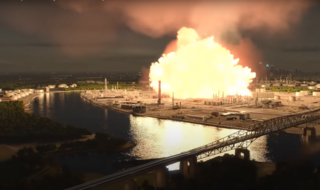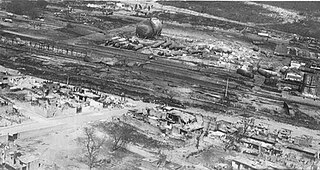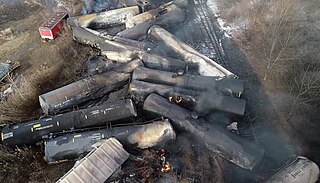
A boiling liquid expanding vapor explosion is an explosion caused by the rupture of a vessel containing a pressurized liquid that is or has reached a temperature sufficiently higher than its boiling point at atmospheric pressure. Because the boiling point of a liquid rises with pressure, the contents of the pressurized vessel can remain a liquid as long as the vessel is intact. If the vessel's integrity is compromised, the loss of pressure drops the boiling point, which can cause the liquid to convert to gas expanding rapidly. BLEVEs are manifestations of explosive boiling.

A tank car or tanker is a type of railroad car or rolling stock designed to transport liquid and gaseous commodities.

The Graniteville train crash was an American rail disaster that occurred on January 6, 2005, in Graniteville, South Carolina. At roughly 2:40 am EST, two Norfolk Southern trains collided near the Avondale Mills plant in Graniteville. Nine people were killed and over 250 people were treated for toxic chlorine exposure. The crash was determined to be caused by a misaligned railroad switch.

The Weyauwega derailment was a railroad accident that occurred in Weyauwega, Wisconsin, United States, in the early morning hours of March 4, 1996. The derailed train was carrying a large quantity of hazardous material, which immediately caught fire. The fire, which involved the train cars and an adjacent feed mill, burned for more than two weeks after the actual derailment, resulting in the emergency evacuation of 2,300 people for 18 days, including the entire city of Weyauwega, with about 1,700 evacuees.

On March 15, 1999, Amtrak's southbound City of New Orleans passenger train collided with a semi-trailer truck in the village of Bourbonnais, Illinois, United States. Most of the train derailed, killing eleven people. A National Transportation Safety Board (NTSB) investigation into the accident attributed the cause to the truck driver trying to beat the train across a grade crossing. The NTSB's recommendations from the accident included increased enforcement of grade crossing signals, the installation of train event recorders at all new or improved grade crossings, and procedures to provide emergency responders with accurate lists of all crew members and passengers aboard trains. The city of Bourbonnais erected a memorial near the site to commemorate those killed in the accident.

The Mississauga train derailment, also known as the Mississauga Miracle, occurred on November 10, 1979, in Mississauga, Ontario, Canada, when a CP Rail freight train carrying hazardous chemicals derailed and caught fire. More than 200,000 people were evacuated in the largest peacetime evacuation in North America until Hurricane Katrina. The fire was caused by a failure of the lubricating system. No deaths resulted from the incident.

The San Bernardino train disaster, was a combination of two separate but related incidents that occurred in San Bernardino, California, United States: a runaway train derailment on May 12, 1989; and the subsequent failure on May 25, 1989, of the Calnev Pipeline, a petroleum pipeline adjacent to the tracks which was damaged by earth-moving equipment during the crash cleanup.
The Los Alfaques disaster was a road tanker explosion that occurred near a holiday campsite on Tuesday 11 July 1978 in Alcanar, Spain. The exploding truck, which was carrying 23 tons of highly flammable liquefied propylene, killed 215 people and severely burned 200 more. Several individuals from the company that owned the vehicle were prosecuted for criminal negligence. The accident resulted in new legislation in Spain, restricting the transit of vehicles carrying dangerous cargo through populated areas to night time only.

The San Juanico disaster involved a series of fires and explosions at a liquefied petroleum gas (LPG) tank farm in the settlement of San Juan Ixhuatepec, municipality of Tlalnepantla de Baz, State of Mexico, Mexico on 19 November 1984. The facility and the settlement, part of Greater Mexico City, were devastated, with 500–600 victims killed, and 5000–7000 suffering severe burns. It is one of the deadliest industrial disasters in world history, and the deadliest industrial accident involving fires and/or explosions from hazardous materials in a process or storage plant since the Oppau explosion in 1921.

On February 16, 1996, a MARC commuter train collided with Amtrak's Capitol Limited passenger train in Silver Spring, Maryland, United States, killing three crew and eight passengers on the MARC train; a further eleven passengers on the same train and fifteen passengers and crew on the Capitol Limited were injured. Total damage was estimated at $7.5 million.

In rail transport, the U.S. DOT-111 tank car, also known as the TC-111 in Canada, is a type of unpressurized general service tank car in common use in North America. Tank cars built to this specification must be circular in cross section, with elliptical, formed heads set convex outward. They have a minimum plate thickness of 7⁄16 inch (11.1 mm) and a maximum capacity of 34,500 US gallons. Tanks may be constructed from carbon steel, aluminum alloy, high alloy steel, or nickel plate steel by fusion welding.

The 1990 Back Bay, Massachusetts train collision was a collision between an Amtrak passenger train, the Night Owl, and a Massachusetts Bay Transportation Authority (MBTA) Stoughton Line commuter train just outside Back Bay station in Boston, Massachusetts, United States. An investigation by the National Transportation Safety Board (NTSB) found that the Amtrak train entered a speed-restricted curve at excessive speed, causing the train to derail and crash into the MBTA commuter train on an adjacent track. Although no one was killed in the accident, 453 people were injured and Back Bay station was closed for six days. Total damage was estimated at $14 million. The accident led to new speed restrictions and safety improvements in the vicinity of Back Bay and a revamp of Amtrak's locomotive engineer training program.

The 2015 Mount Carbon train derailment refers to a derailment in Mount Carbon, West Virginia, on February 16, 2015, which involved a CSX Transportation train hauling 107 tank cars of crude oil from North Dakota to Virginia. It resulted in a large oil spill that caught fire with several subsequent large, violent fireball eruptions. The spill, fire, and eruptions destroyed one home, forced the evacuation of hundreds of families and caused the temporary shut down of two nearby water treatment plants. Eventually, 19 railcars carrying crude oil caught fire with each car carrying up to 30,000 US gallons of crude oil.
The 2015 Tennessee train derailment occurred on July 2, 2015. A CSX Transportation train derailed at Maryville, Tennessee. The train was carrying toxic chemicals, leading to an evacuation of over 5,000 people.

A train derailment occurred on February 3, 2023, at 8:55 p.m. EST (UTC−5), when 38 cars of a Norfolk Southern freight train carrying hazardous materials derailed in East Palestine, Ohio, United States. Several railcars burned for more than two days, with emergency crews then conducting a controlled burn of several railcars, which released hydrogen chloride and phosgene into the air. As a result, residents within a 1-mile (1.6-kilometer) radius were evacuated, and an emergency response was initiated from agencies in Ohio, Pennsylvania, West Virginia, and Virginia.
At 4:25 pm on July 8, 1986, a 44 car Baltimore and Ohio railroad freight train, traveling at 45 miles per hour, bound south to Cincinnati, derailed near Miamisburg, Ohio, a small city with an industrial history in Montgomery County, southwest of Dayton. Fifteen of the cars derailed on a bridge; these were tank cars containing yellow phosphorus, molten sulfur and tallow. Carrying a chemical used to make rat poison, fireworks and luminescent coatings, one tank car caught fire. This resulted in emission of an estimated 1,000 foot (300 m) high cloud of phosphorus. A subsequent incident caused the largest train accident-triggered evacuation at the time in the United States. The accident was the second major rail disaster in Miamisburg within an eight-year period. On September 10, 1978, 15 cars of a Conrail train derailed.













